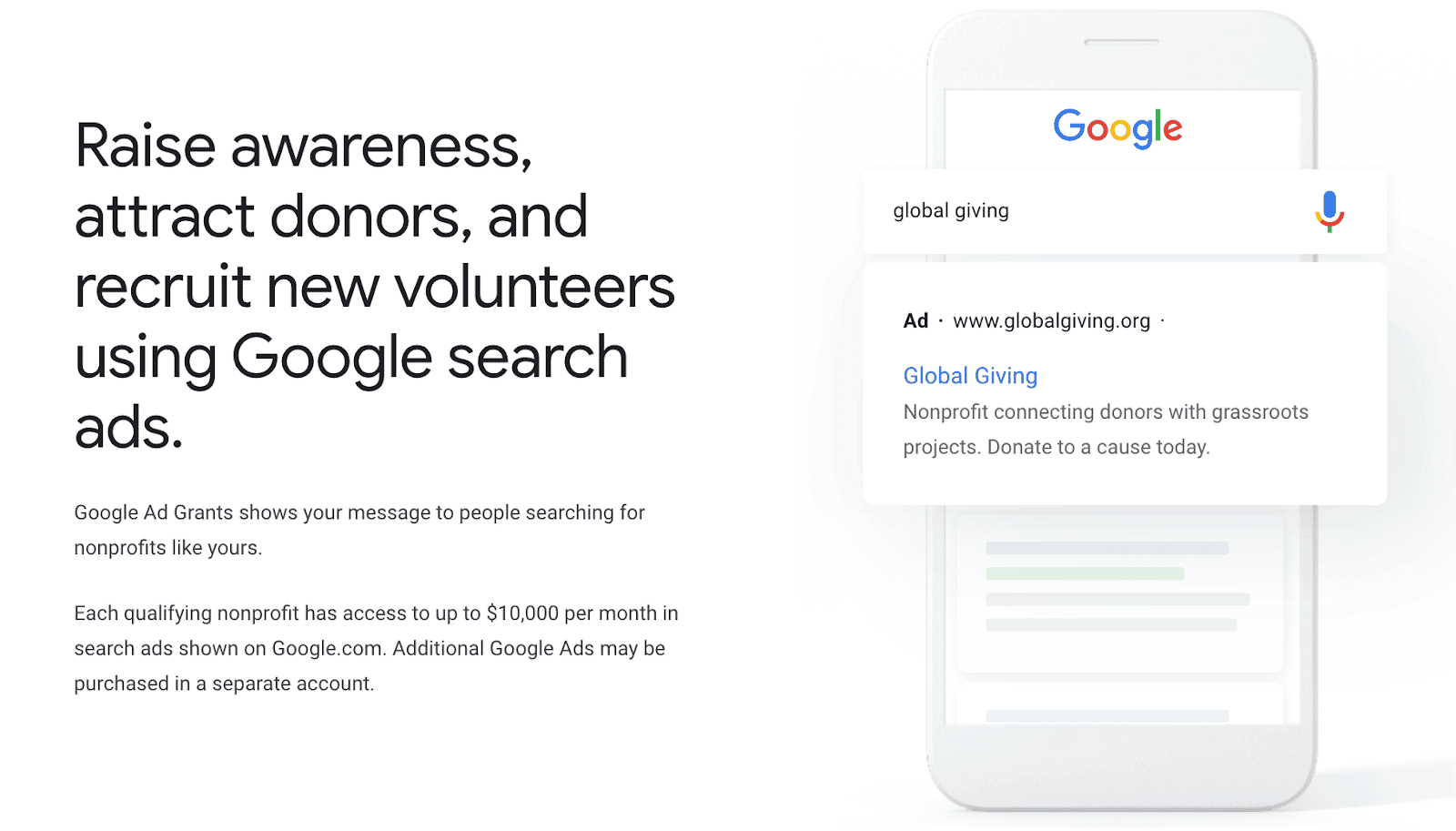Marketing
How to Get Google Ad Grants for Nonprofits
July 6, 2021
7 mins

Did you know that Google gives away free advertising dollars to nonprofits? Up to ten thousand dollars a month to be exact! Sounds too good to be true, right?
With the exception of government entities, schools, and health care organizations (sorry guys!), nonprofits can take advantage of this free chance to reach more people with their important messages.
And yet, there are many nonprofit leaders who are unaware of this opportunity. Or maybe you’ve thought about creating a Google for Nonprofits account but felt like it was too complicated to understand or you haven’t had time to explore it further.
We build websites and create digital marketing strategies for many nonprofit organizations and know that you are always on the lookout for ways to maximize your marketing dollars. But we also know that many nonprofit leaders are spread thin and wear multiple hats.
So in this post, we are simplifying the details so you can quickly understand the Google Ads Grant program, how to apply for it, and what Google will expect of you once your nonprofit is approved.
 (Image Source)
(Image Source)
Google Ads for Nonprofits: The Basics
Google Ad Grants give nonprofit organizations the opportunity to apply for grants totaling $10,000 per month in free Google advertising. This means that qualifying nonprofits can leverage opportunities to promote their work and reach more people for free.
We want to help nonprofits understand how Google Ads work and determine whether or not a Google Ads Grant would be a good choice for your organization. But before we dive deep, here are a few technical terms you’ll see pop up a lot in discussions about Google ads:
SERP: Search Engine Results Page. This is the page that appears after you type in a query on Google.
PPC: Pay-Per-Click advertising. This means that you’re only charged when a searcher clicks on the ad. Google calls their pay-per-click functionality Google Ads. Google Ads always appear at the top of the SERP.
SEO: Search Engine Optimization. This applies to a specific strategy to create website content that Google recognizes as meaningful and relevant and results in a higher placement on the Google SERP. Organic results always appear below the paid ads.
Google Ads: A paid advertising opportunity to get top placement on Google’s SERP by bidding on specific keywords.
What’s a Google Ad and How Does it Work?
In order to understand how Google ads for nonprofits work, it’s important to first understand how Google Ads work. Google Ads is Google’s version of PPC advertising that gives businesses and organizations the opportunity to bid for the top spot on the search engine results page (SERP).

Anytime you run a query on Google, you’ll see two different kinds of results: ads (paid) results and organic (SEO) results. The paid results are always at the top and are based on how much money a company is willing to spend on specific keywords. Organic results are very difficult to manipulate and require intentional search engine optimization (SEO) to be successful.
On the other hand, it’s much easier to achieve top placement on the SERP if you’re paying to be there. But most nonprofits don’t have unlimited budgets to bid on popular words. Recognizing this, Google offers nonprofits the chance to qualify for $10,000 a month in Google Ads. This generous opportunity can give nonprofits a headstart in getting their message in front of the right people.
It’s important to note that this isn’t a watered down version of Google Ads. The Google Ads Grant gives nonprofits up to ten thousand dollars to spend on PPC advertising within the full Google Ads system. You get all the features and benefits of Google Ads and 10K to spend per month. But there are a few requirements you must fulfill to maintain good standing with Google.
(Read More: Hidden Benefits of PPC Advertising)
Eligibility Requirements for Google Ad Grants
Before you get too far down in the Google Ad Grants process, check to see that your nonprofit meets the Google Ad Grants eligibility requirements. Your nonprofit must meet a certain set of criteria and maintain that benchmark for the duration of the grant or Google will suspend your account (and they do check). But before we get into what you have to do to keep the grant, here is what you need to get started:
- The first requirement is that your nonprofit is not a government entity, school or health care organization.
- Your nonprofit must have official nonprofit status in the country in which you’re based. Here is a list of eligible countries:

- You must have a Google for Nonprofits account. This is similar to a Google My Business account but designed with tools and resources relevant to the needs of nonprofits. When you create a Google for Nonprofits account, you will then need to get verified by TechSoup. If your nonprofit is based in the United States, Google will automatically do this for you. If you’re based in another country, there are steps you need to take to set up a TechSoup account. You can learn more about TechSoup verification on Google’s website.
With those steps complete, your nonprofit can now submit a request for the Google Ads Grant within the Google for Nonprofits console.
What Google Expects from You
Now that you’ve met the eligibility requirements and have set up a Google for Nonprofits account, Google will evaluate your website to see if it meets a certain quality standard. Some of the things Google will look for include:
- Website security, load-time, clean code, and broken links
- Quantity and quality of useful and meaningful content updated regularly
- Limited commercial activity including the use of ads on your website
When Google approves your account, you then must maintain eligibility by keeping the account active. The Google Ads Grant maintenance requirements include:
- Run ad campaigns that are of high quality and relevant to the content on your website
- Geotag locations relevant to your organization
- Don’t go after Not selecting your competitor’s name as a keyword, e.g. branded keywords
- Maintain a minimum keyword quality score 3 or higher
- Continue to maintain a high quality website
- Only send traffic to your website domain, e.g. you can send your ad traffic to your Facebook page
- Update your account every 90 days at minimum
- Respond to all surveys Google sends to you about your account
There are a lot of details in maintaining your account that need to be followed but the biggest thing to note here is this: make a plan to actually use the grant before you apply. There are many actions that Google will hold your nonprofit responsible for and if you don’t have a plan to keep up with the program, it’s probably better to wait until you’re ready to fully engage with the program rather than rushing to apply only to have your account suspended.
We will soon have a follow up post with tips on how to make the most of your Google Ads Grant so stay tuned for that in the coming weeks!
Is the Google Ad Grant Right For Your Nonprofit?
If you’re able to keep your account active and have the manpower to manage it, we see no reason why your nonprofit shouldn’t pursue a Google Ad Grant. But keep in mind that while this is technically “free money” there is a good bit of work you must do to set up, learn, and maintain. You may want to consider putting some of those marketing dollars you saved toward hiring someone to manage your ad grants for you.
There is a lot of highly technical information involved in understanding Google Ads and applying for grants, but you don’t have to do it alone. If you have questions or want help navigating the process, please give us a call. We would love to help you evaluate whether or not this opportunity would benefit your organization. If you want to learn more about other PPC or SEO opportunities we can talk about that, too. Let’s schedule a time to meet and discuss how to make the most of your nonprofit marketing budget!

